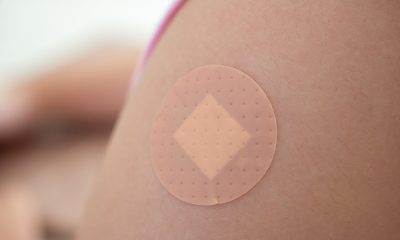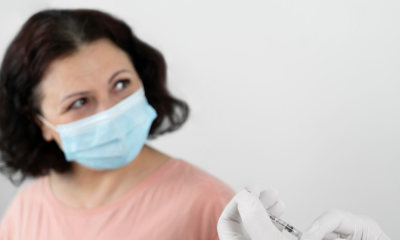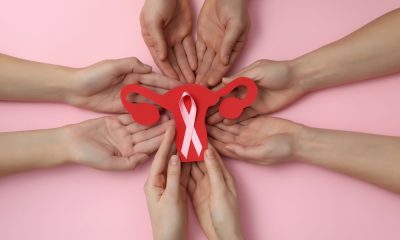Cancer
Air pollution may increase breast cancer risk, study suggests

Long-term exposure to air pollution may increase the risk of breast cancer, with a study of more than 400,000 women showing higher rates in areas with poor air quality.
Researchers tracked 28,000 breast cancer cases over several decades, following participants for up to 10 years before diagnosis and monitoring changes in their home addresses.
They compared these data with pollution readings from more than 2,600 monitoring sites across the country.
The analysis was carried out by researchers from Oregon State University, the National Institutes of Health (NIH), Harvard University and several other US institutions.
A 10-parts-per-billion rise in nitrogen dioxide – a pollutant linked to vehicle exhaust – was associated with a 3 per cent increase in overall breast cancer incidence.
Based on an estimated 316,950 cases expected in the US this year, a 3 per cent reduction could mean 9,500 fewer diagnoses.
The study also found that a 5-microgram-per-cubic-metre increase in PM2.5 – fine airborne particles small enough to penetrate deep into the lungs – was linked to a higher incidence of hormone receptor-negative breast cancers.
These tumours lack oestrogen and progesterone receptors, making them generally harder to treat.
Average nitrogen dioxide levels in the study were below current Environmental Protection Agency guidelines, suggesting even legally acceptable pollution levels may still pose health risks.
Veronica Irvin is associate professor at Oregon State University’s College of Health.
She said: “It’s often not realistic for people to move to areas with better air quality in search of lower health risks, so we need stronger clean air laws to protect those most affected.
“We also need policies that help to reduce car traffic and promote alternative forms of transportation.”
Breast cancer rates in the US have risen over the past four decades, despite the country having lower pollution levels than many other populous nations.
The disease affects around one in eight women and is the second leading cause of cancer death among women after lung cancer.
There are currently more than 4 million breast cancer survivors living in the US.
Diagnosis
Researchers develop nasal therapeutic HPV vaccine

Researchers have created a therapeutic HPV vaccine delivered through the nose that could offer a non-invasive treatment for cervical cancer.
Screening for HPV and preventive vaccines lower risk, but there are no approved therapies for existing HPV infections or HPV-linked cancers.
Current treatments include surgery, radiotherapy and chemotherapy.
Researchers from Chiba University, Japan, led by associate professor Rika Nakahashi-Ouchida and Ms Hiromi Mori of Chiba University Hospital, have developed an intranasal therapeutic option.
Unlike injectable vaccines, nasal vaccines trigger immunity at the mucosal surface — the protective lining of the upper airway.
This mucosal response can also protect distant sites, including the reproductive tract.
Building on earlier work showing nasal immunisation can elicit strong genital-tract responses against herpes simplex virus type 2, the team used cationic nano-sized hydrogel particles (cCHP nanogels) to deliver HPV antigens to nasal tissues.
These positively charged spheres adhere to the negatively charged nasal surface and slowly release antigens, which prompt an immune response.
Nakahashi-Ouchida said: “We have developed an intranasal therapeutic vaccine as a non-surgical alternative to conventional treatments that can compromise women’s quality of life.
“This novel nasal vaccine activates the mucosal homing pathways of lymphocytes, allowing it to trigger an immune response in the cervical mucosa, a site from the nasal administration.”
The formulation targets the E7 oncoprotein from HPV16, which inactivates pRb, a key tumour suppressor.
To strengthen responses, the researchers added cyclic-di-AMP, an adjuvant that boosts T-cell-mediated immunity so T cells can attack infected or cancerous cells.
The resulting cCHP-E7 + c-di-AMP showed what the researchers describe as strong anti-tumour activity in mice and macaques. In mouse models, it significantly slowed tumour growth versus controls.
In macaques, a nasal spray device (usable in humans) delivered four doses.
Vaccinated animals developed high levels of E7-specific helper and killer T cells producing molecules linked to tumour control; controls did not.
Immune activity was detected in cervical tissue, and E7-specific killer T cells persisted for at least four months, suggesting lasting defence.
According to the World Health Organization, cervical cancer caused an estimated 660,000 new cases and 350,000 deaths in 2022.
If proven safe and effective in humans, intranasal therapy could offer a non-invasive, fertility-preserving alternative to surgery for some patients.
The cCHP nanogel platform may also support nasal vaccines against other pathogens and wider clinical uses.
Nakahashi-Ouchida said: “Immunotherapies such as intranasal therapeutic vaccines may help establish a new category of non-invasive treatment.
“These approaches could be extended to recurrence prevention and chronic disease management, offering patients safer and more accessible options.”
News
Smart textiles bra could help detect cancer in women with intellectual disabilities

Women with intellectual disabilities could receive added monitoring for breast cancer with the development of a smart textiles bra by researchers at Nottingham Trent University (NTU) and the University of Glasgow (UofG).
Funded by Cancer Research UK, a team of scientists and designers are developing an electronic textile which would fit inside a bra and monitor whether a tumour is growing in real time, before alerting clinicians to potential risks.
Although women with intellectual disabilities have a lower incidence of breast cancer, they face significantly higher mortality rates due to barriers in accessing current screening methods.
The research is led by Professor Yang Wei of the Nottingham School of Art & Design (NSA&D) and Professor Deborah Cairns, director of SLDO (UofG).
Professor Wei said: “Breast cancer can develop over time, and while some types grow quickly, others may progress slowly, making early detection critical for improving survival outcomes.
“This technology has the potential to save women’s lives by detecting tumours early, while being used as an added measure alongside all other normal checks and scans.”
“As MRI scans can be months apart, patients could be given better peace of mind by knowing that any growth between monitoring appointments would be picked up.
“We hope in the future that this technology could reduce the need for many other checks, such as MRI, ultrasound and mammograms, and in doing so create efficiencies for health services.”
The research is being developed at NTU’s Medical Technologies Innovation Facility (MTIF) and the Scottish Learning Disabilities Observatory (SLDO) at UofG, with an investment of around £100,000 from Cancer Research UK.
The technology uses a form of electrical current that can scan to spot subtle differences in body tissues.
Because tumours tend to be denser and hold less water than healthy areas, the device can help differentiate them.
The technology has the potential to detect growths as little as 5mm – enabling earlier detection and triggering other scans to be taken, such as MRI.
The device would record data and provide feedback via smartphone to the wearer, carers and clinicians so that assessments can be made.
It will be co-designed with input from women with intellectual disabilities, carers, and healthcare professionals to ensure usability and effectiveness.
The research team says there’s potential for the technology to be developed as part of a new bra altogether, as well as an insert.
Cancer Research UK figures show, there are 56,900 new cases of breast cancer in the UK every year, with around 11,200 breast cancer deaths.
Research information manager at Cancer Research UK, Dr Dani Skirrow, said: “Over the past 50 years, our work has helped to nearly double breast cancer survival in the UK.
“We’re committed to making sure everyone shares in this progress equally, regardless of who they are, where they’re from or what type of cancer they have.
“The ‘Smart Bra’ has the potential to make breast cancer screening more accessible so that more people can benefit from it.
“This would help us to detect more breast cancers at the earliest stage, when treatments are most likely to work.
“We’re supporting our scientists to develop innovative technologies like the ‘Smart Bra’ to make sure the benefits of research are shared by everyone.”
Wellness
Research highlights challenges faced by young women with advanced breast cancer

Nearly half of women under 40 with advanced breast cancer have children under 18, with many facing job disruption and financial strain, new research has found.
A global survey has revealed the challenges faced by young women with advanced breast cancer, with 64 per cent reporting employment disruption after diagnosis and 40 per cent incurring medical debt.
Findings from 385 women under 40 living with advanced breast cancer across 67 countries were presented at the Advanced Breast Cancer Eighth International Consensus Conference (ABC8) in Lisbon.
The Project 528 survey was led by the Young Survival Coalition.
Advanced breast cancer (ABC) occurs when the disease spreads beyond the original tumour to other parts of the body. While treatments can slow progression, it remains incurable.
Financial security fell from 51 per cent before diagnosis to just 3 per cent after treatment began.
Although 84 per cent said they felt able to ask questions at diagnosis, 40 per cent delayed seeking care – often because primary care physicians dismissed their concerns, or due to lack of awareness or fear.
Jennifer Merschdorf, chief executive officer of Young Survival Coalition, said: “We launched Project 528 to fill a critical gap – the voices of young adults living with advanced breast cancer are often under-represented in clinical discussions and policy dialogues.
“For the first time, we now have global data that reflect the voices of young women with advanced breast cancer.
“This survey gives us the evidence we need to understand their unique challenges and to ensure that research, services and policies are shaped by their lived experiences – not by assumptions.”
Of the 385 women surveyed, 48 per cent had children under 18. Only 14 per cent were diagnosed through clinical screening or routine check-ups, while 85 per cent detected the disease themselves after noticing symptoms.
Eighty per cent reported psychological distress. Concerns about body image, fertility and sexual health were widespread but rarely addressed.
Practical challenges such as childcare, housekeeping and transport were common, leaving many with unmet needs.
Access to precision diagnostics varied.
While 90 per cent received genetic testing for inherited mutations – changes in DNA passed down from parents – only 59 per cent had genomic testing of tumours.
This identifies mutations within the cancer itself, helping doctors understand tumour activity and recurrence risk to guide treatment.
Although 77 per cent said they understood their treatment plans, 25 per cent lacked clarity and only 46 per cent were offered more than one treatment option.
Understanding of targeted therapies – drugs designed to attack specific cancer cell features – was the lowest among treatment types.
Online communities were an important source of information and support, but only 43 per cent of respondents were referred to them by their care teams.
“Our analysis of young women living with ABC underscores a consistent theme,” said Merschdorf.
“The current standard of care, while medically advanced, remains deeply fragmented when it comes to the lived realities of younger ABC patients.
“From diagnosis delays to unmet psychosocial needs, patients face a system that too often demands self-advocacy in the face of fatigue, fear and financial strain.”
The Young Survival Coalition plans further research to explore the unique needs of younger patients with ABC.
“Advanced breast cancer poses a complex set of challenges for younger adults, whose experiences with this incurable illness intersect with critical phases of career, parenting and identity development.
“Project 528 provides a roadmap for researchers to investigate the issues that respondents identified as the most pressing, while also guiding supportive services and advocacy organisations to align their programmes with those needs.
“Beyond research and services, these findings can inform the development of health policies that better reflect and support the lived experiences of young adults facing breast cancer.
“Ultimately, the goal is for these data to drive meaningful improvements in research, care and policy that truly serve this community.”
Professor Fatima Cardoso, medical oncologist and president of the ABC Global Alliance, said: “This is an important study that shows, for the first time, the experiences of young patients living with advanced breast cancer and the challenges they face in their daily lives.
“It is concerning that not all of the women in this study were offered tests to see whether or not they had inherited cancer-causing genetic mutations, and to understand the biology of the tumour itself.
“In an age of precision medicine, all breast cancer patients should have access to these tests as they have a crucial role in treatment decision-making and hence impact on survival and quality of life.
“I hope that policymakers will take note of the results of this study and address the many gaps that it highlights in terms of diagnosis, treatment and supportive care, but also psychosocial and financial support.”
-

 News3 weeks ago
News3 weeks agoDozens of women report suffering painful burns after using Always sanitary towels
-

 News4 weeks ago
News4 weeks agoCutting through the noise in femtech – key takeaways from Women’s Health Week 2025
-

 News3 weeks ago
News3 weeks agoAI embryo selection tool wins European approval
-

 News6 days ago
News6 days agoOpinion: Not ‘just stress’ – How hormonal changes affect women’s brain function
-

 Hormonal health3 weeks ago
Hormonal health3 weeks agoTestosterone patch shows promise for menopausal women
-

 Diagnosis4 weeks ago
Diagnosis4 weeks agoScientists develop breakthrough approach to detecting endometriosis in menstrual blood
-

 Entrepreneur3 weeks ago
Entrepreneur3 weeks agoFrom SEO to GEO: How women’s health brands can get found in the age of AI
-

 Wellness3 weeks ago
Wellness3 weeks agoFDA approves new menopause drug to treat hot flashes and night sweats





























1 Comment